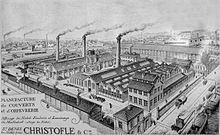Christofle
Coordinates: 48 ° 52 ′ 4 ″ N , 2 ° 19 ′ 21 ″ E
| Orfèvrerie Christofle SA
|
|
|---|---|
| legal form | société anonyme |
| founding | 1830 |
| Seat | Paris , France |
| management | Thierry Oriez , President |
| Branch | Manufacturing |
| Website | www.christofle.com |
The Orfèvrerie Christofle is a French manufacturer of fine silver flatware, headquartered at the Rue Royale 9 in Paris . It is known for its silverware as cutlery and service , as well as silver picture frames , crystal vases , glassware , china and silver jewelry famous.
history
Beginnings in the 19th century
In 1830 the jeweler Charles Christofle (1805–1863) founded the company. In 1842 he bought the electroplating patent from the Englishmen Henry and George Richards Elkington and the French Count Henri de Ruolz. A large factory was set up on rue de Bondy , which was one of the first plants in the world to use electricity . This plant was to remain in operation until 1933. In 1846, King Ludwig Philipp I commissioned a silver service for Eu Castle , and Christofle became a supplier to the Orléans family. After the fall of the July monarchy , Christofle became Emperor Napoleon III's supplier . who ordered a service for the Palais des Tuileries . At the Great Exhibition in London, Christofle received a medal, the first of a series. From Étienne Lenoir in 1851 he acquired a refined process for silvering metallic objects. In 1852 Henri Bouilhet (1830-1910), a nephew of Charles Christofle, joined the company after graduating from the École Centrale des Arts et Manufactures . In 1853 Christofle registered his trademark ( poinçon ). As part of the expansion, a new factory was opened in Karlsruhe in 1854 , but it closed in 1921. In April 1855, Emperor Napoleon III awarded Charles Christofle the purveyor to the court .
Sultan Abdülaziz attended the Paris World's Fair in 1855 , where he ordered a number of gifts from Christofle for his daughter's wedding. Christofle was the sultan's supplier and over the years was to produce several works for him, such as a 75 kilogram chandelier, a silver-plated and gold-plated table and other items. Christofle operated several branches in the Ottoman Empire.
at the end of the 19th century
After the death of Charles Christofle in 1863, his son Paul Christofle (1838–1907) and his nephew Henri Bouilhet became managing directors. In 1866 Napoleon III. commissioned a vermeil service (gold-plated silver). At the Paris World Exposition in 1867 presented his first Christofle cloisonné - enamel work before with a series of Japanese-inspired silverware.
In 1868 Christofle was commissioned to work on the monumental statue of Our Lady with Child for the Notre-Dame de la Garde church in Marseille, the largest galvanized piece in the world. Two large statues were made for the Opéra Garnier in 1869, Harmony on the left and Poetry on the right. The statues are 9.7 meters high and weigh six tons each.
In 1873 Christofle took part in the Vienna World Exhibition and received honorary awards for Japanese-inspired works. The Japanese emperor commissioned two cloisonné enamel vases for the exhibition. Christofle & Cie. also supplied the imperial court in Vienna as an imperial and royal court supplier , his comptoir was at Opernring 5 in the 1st district.
The plant in Saint-Denis was opened in 1876 and remained in operation until 2004.
On the occasion of the art metal exhibition in Paris, Christofle presented a silver coffee pot by Henri Carrier-Belleuse, which was called L'Union fait le succès . The Carrier-Belleuse coffee pot is still made by hand. In 1882 Christofle was commissioned to manufacture the so-called "Nawab bed", which needed around 640 pounds of solid silver. In 1883 Christofle equipped the Orient Express with silverware. In 1897 Christofle opened his shop at rue Royale 8, 10 and 12 and will remain there until 1992 when it moves to rue Royale 9. For newer products from the Art Nouveau line , Christofle developed a new alloy in 1898, which he calls gallia . In the same year Christofle furnished the Hôtel Ritz .
Nawab bed
In April 1882 Christofle received an extraordinary order through an intermediary from an anonymous customer. The order was for a magnificent bed made of dark wood with decorative silver with gilded parts, monograms and weapons, decorated with four life-size skin-colored female figures holding fans, with real hair, movable eyes and arms. In addition to the silversmiths, a sculptor and painter, a carpenter for the bed, an automation technician and a music box maker were required for the execution . The order had to be carried out in the greatest possible secrecy.
The panels and posts were made of Brazilian rosewood by the Schmidt Piollet company. The silversmith covered the entire structure and covered it with 640 pounds (around 290 kilograms ) of hallmarked and engraved sterling silver in the form of garlands and foliage in flat relief . The headboard was decorated with the coat of arms of the anonymous customer. It consisted of two large pelicans, a shield with three vertical branches, which was crowned by stars, a knight's helmet and a crescent moon . The initials SMK were engraved on the foot. On all four corners of the bed stood naked women with different hair colors and fans in their hands. They presumably represented a French woman, a Spanish woman, an Italian woman and a Greek woman. Her hair was styled by Lesage, one of the most famous hairdressers of his time. When the mattress moved, the built-in technology triggered a mechanism that moved the fans of the female figures and made the eyes blink. At the same time the game clock in 30-minute intervals played Faust by Charles Gounod .
Christofle did not find out the name of his customer until 1983. It was Muhammad Sadiq Khan Abbasi IV, the Nawab of Bahawalpur (in today's Pakistan). The nawab was 20 years old when he commissioned the bed. He grew up under British rule and seemed to be enthusiastic about Western influences. However, he was not to enjoy his bed very long, as he died in 1899 at the age of 38. The “Nawab bed” was exhibited in 2009 at the exhibition Maharaja: The Splendor of India's Royal Courts in London's Victoria and Albert Museum .
20th century
In 1900 the Pivoine ( peony ) lamp was presented, an Art Nouveau masterpiece in which the opal-colored glass was blown directly into the socket during manufacture . At the World Exhibition in Paris in 1900 Christofle exhibited a large number of works of art, such as a 17 kilogram silver mirror and a 71 kilogram centerpiece, also made of silver. In 1917 Christofle presented "Dinanderies", a collection of patinated copper works inlaid with silver and gold . This collection remained in production until 1938.
In 1925 Christofle took part in the Exposition Internationale des Arts Décoratifs et industriels modern in Paris, where it received many awards. In 1928 Gio Ponti created the Fleche (arrow) candlestick , the shape of which heralded the style of the coming 1970s. In 1935 Christofle produced 45,000 pieces for the service of the Normandie cruise ship .
At the 9th Milan Triennale in 1951, which was under the supervision of Gio Ponti, Christofle presented his "Design" collection. In the same year Christofle bought the Cardeilhac company. In 1957 the "Formes Nouvelles" collection, drawn by Gio Ponti, Tapio Wirkkala and the silversmith Lino Sabattini , was presented. In 1960 the Bouilhet-Christofle Museum opens. In 1970 President Georges Pompidou selected the "Mercury" service for the presidential aircraft. In 1971, a modern flatware manufacturing facility opened in Yainville , Normandy. The factory was able to produce over five million pieces a year. In 1974 Jean Michel Folon designed several pieces for Christofle, including the "Bolide" table lighter . In 1989 the "Perspective" collection was presented, a limited silver collection that was created in collaboration with several designers and artists.
Between 1990 and 2004 Christofle worked with several international designers such as Sylvain Dubuisson , who made liturgical objects for Pope John Paul II , Roger Tallon , Adam D. Tihany , Clara Halter , Gae Aulenti , Martin Szekely , Andrée Putman , Michele Oka Doner and Garouste and Bonetti together.
The group's headquarters have been located at 9 Rue Royale in Paris since 1992 .
21st century
In 2005 the Collection 925, Andrée Putman's first silver jewelery collection, was presented. For Christofle this marked a return to the roots when Charles Christofle started his company as a silver jeweler. Other artists Christofle worked with were Taher Chemirik , Adeline Cacheux and Peggy Huyn Kin , who experimented with the L'Esprit Argente brand . Since 2006 there has been collaboration with designers such as Marcel Wanders , Richard Hutten , Ito Morabito (Ora-Ïto), Arik Levy and artists such as Sam Baron , Toni Grilo , students of L'ECAL and Mathieu Lehanneur .
The Christofle company produces in France and Brazil. The products are sold in 75 Christofle retail stores as well as 400 department stores and specialty stores worldwide.
Christofle is also one of the founding members of the Colbert Comité .
Individual evidence
- ↑ Sibel Dorsan: Christofle: A revisited radically. In: Diplomat. June 2006, accessed on March 27, 2010 (English): “Even as early as the 1860s, Christofle had ten stores in the Ottoman Empire. The ruler who introduced this renowned brand of the fine art of dining to Turkey was Sultan Abdulaziz. In the While visiting Toulon in 1855, the Sultan traveled on to Paris to visit the First International Paris Fair where he ordered wedding presents for his daughter from Christofle. Experts today list a number of silver items with the Sultan's imperial emblem engraved on them, as well as a 75 kg chandelier, a table embellished with silver and gold, and a washbowl decorated with a pattern depicting the Arabian Nights - all ordered by Abdülaziz and created by Christofle, already the Sultan's fourisseur before that date - among the most invaluable pieces of antiques available in the world today. "
- ↑ David Lister: India's royal riches: The maharajas' opulent lifestyle. In: The Independent . September 7, 2009, accessed on March 27, 2010 (English): "Rolls-Royces, jeweled swords and couture saris - the V & A's majestic exhibition reveals the opulent lifestyle of the maharajas."
- ↑ Amin Jaffer: Made for Maharajas: A Design Diary of Princely India . Vendome Press, New York 2006, ISBN 978-0-86565-174-6 (English).
- ↑ Chumki Bharadwaj: Style on a silver platter. In: India Today . February 22, 2008, accessed March 27, 2010 .
literature
- Ingrid Haslinger: Customer - Kaiser. The story of the former imperial and royal purveyors . Schroll, Vienna 1996, ISBN 3-85202-129-4 .
- Christofle & Cie Orfèvres . Editions Collections Livres SC, 2004 (in French).
- Des cheminees dans la plaine: Cent ans d'industrie a Saint-Denis, autour de Christofle (1830–1930) . Creaphis, 1998. ISBN 978-2-907150-85-9 (in French).
- Marc de Ferriere Le Vayer: Christofle, deux siecles d'aventure industrial: 1793–1993 (Collection Memoire d'entreprises) . Le Monde editions, 1995. ISBN 978-2-87899-105-5 . (in French).
- Tony Bouilhet: L'Orfèvrerie francaise, au XX siecle et le centenaire de l'orfèvrerie Christofle . Editions Emil-Paul Freres, 1941 (in French).
- David Rosenberg: Christofle . Assouline, 2006. ISBN 978-2-84323-657-0 (in English).
Web links
- Christofle's website
- Revue de la Société d'Entraide des Membres de la Légion d'Honneur, No. 107, May 1990, pp. 16-18: Biography Jean-Joseph Etienne Lenoir (1822-1900) (French, PDF, 88 KiB) (accessed on July 17, 2013)







